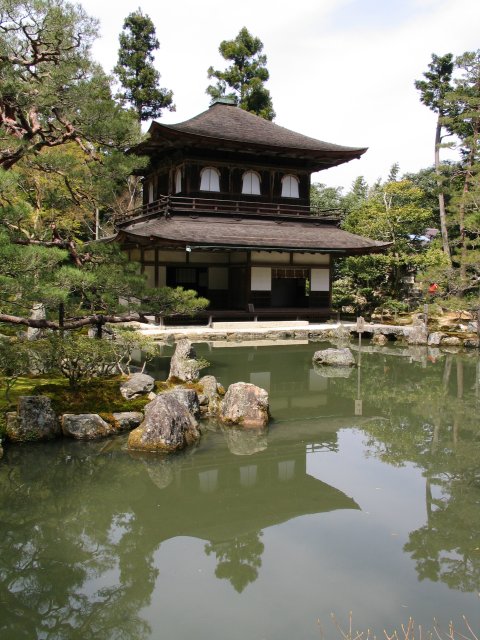- Ginkaku-ji
Infobox Buddhist temple
name = Ginkaku-ji
銀閣寺

img_size =
img_capt = The Silver Pavilion
landscape = no
denomination =Rinzai Zen
founded = 1490
closed =
founder =Ashikaga Yoshimasa ,Musō Soseki
teacher =
director =
roshi =
abbot =
priest =
rinpoche =
reverend =
address =Ginkaku-ji-chō 2,Sakyō-ku, Kyoto
country =flagicon|JapanJapan
phone =
website = [http://www.shokoku-ji.or.jp/english/e_ginkakuji/ http://www.shokoku-ji.or.jp/] nihongo|Ginkaku-ji|銀閣寺|, the "Temple of the Silver Pavilion," is a Buddhist temple in the Sakyo ward ofKyoto ,Japan . The official name is Jishō-ji (慈照寺, "Temple of Shining Mercy"). It was built in1474 by theshogun Ashikaga Yoshimasa , who sought to emulate the goldenKinkaku-ji commissioned by his grandfatherAshikaga Yoshimitsu . The temple is part of theShokoku-ji branch ofRinzai Zen.The Kannon hall is the main building at the temple. It is popularly known as "Ginkaku", the Silver Pavilion. There is a popular account: "The intention was to cover it in silver, but due to the increasing severity of the
Ōnin War , which broke out several years earlier in1467 , construction was halted, and the silver covering never placed on the pavilion". However, time-honored trees and great stones which were collected from various places in Japan are used for the temple, thus, cost was spent luxuriously to build the temple. Therefore, it is difficult to consider that only the cost of the silver foil was saved. And, the silver has not been detected at all as for scientific researches done in January 2007. Therefore, the present appearance of the temple is thought as be based on the original intention of Ashikaga Yoshimasa, that is "wabi-sabi ".Like Kinkaku-ji, Ginkaku-ji was originally built to serve as a place of rest and solitude for the Shogun. During his reign as Shogun, Ashikaga Yoshimasa inspired a new outpouring of traditional culture, which came to be known as "
Higashiyama Bunka ", the Culture of the Eastern Mountain. Having retired to the villa, it is said Yoshimasa sat in the pavilion, contemplating the calm and beauty of the gardens as the Ōnin War worsened and Kyoto was burned to the ground. In1485 , Yoshimasa became aZen Buddhist monk, and after his death the villa became a Buddhist temple, renamed Jishō-ji.In addition to that building, the temple features wooded grounds covered with a variety of mosses, and a
Japanese garden , supposedly designed by the great landscape artistSoami . The rock and sand garden of Ginkaku-ji is particularly famous, and a pile of sand said to symbolizeMount Fuji has now come to be a part of the garden.As from February 2008 Ginkaku-ji is undergoing extensive restoration, however its gardens are still open to the public.
ee also
*
Historic Monuments of Ancient Kyoto (Kyoto, Uji and Otsu Cities) External links
* [http://www.shokoku-ji.or.jp/english/e_ginkakuji/ Ginkaku-ji]
Wikimedia Foundation. 2010.
